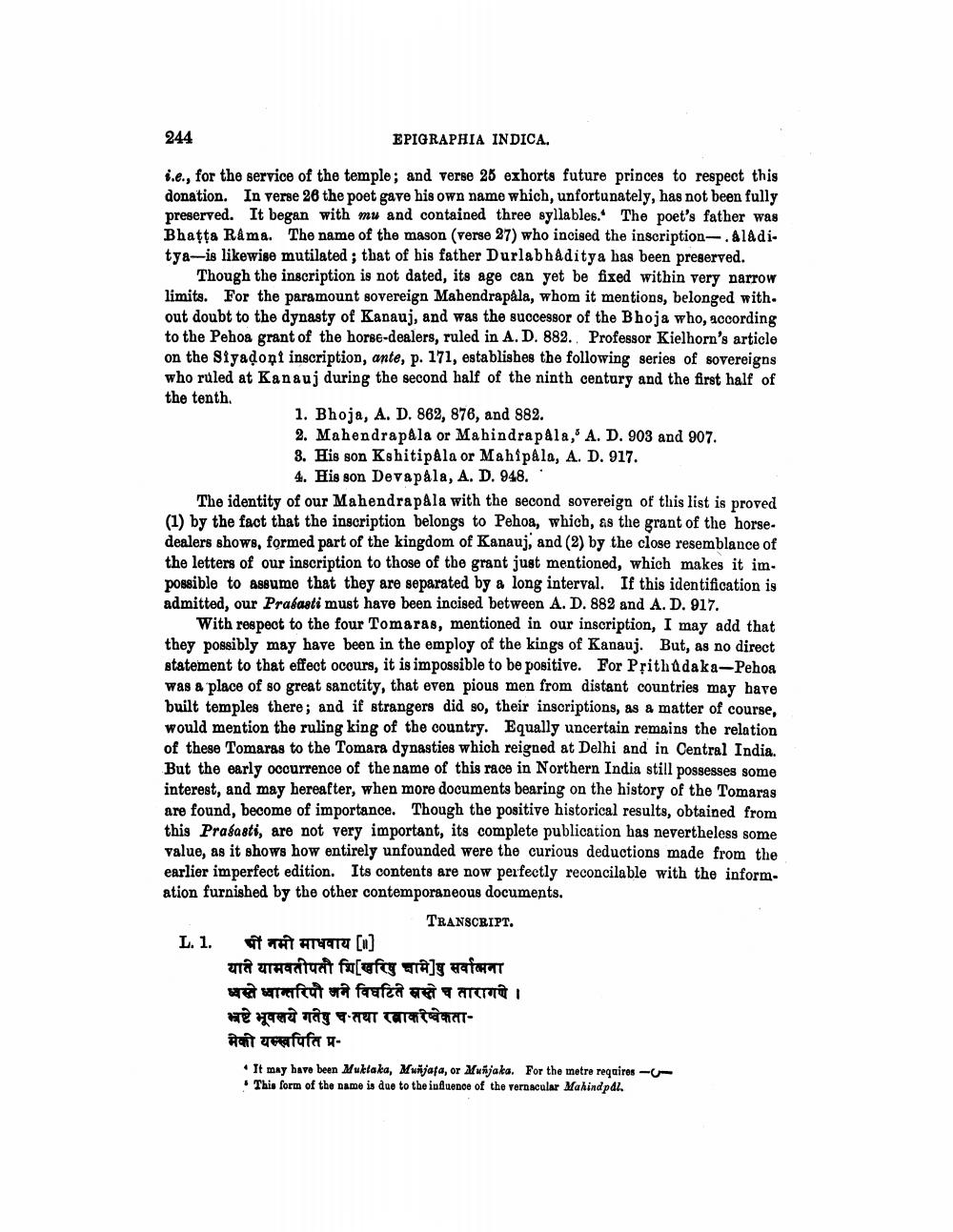________________
244
EPIGRAPHIA INDICA.
1.e., for the service of the temple; and verse 25 exhorts future princes to respect this donation. In verse 26 the poet gave his own name which, unfortunately, has not been fully preserved. It began with mu and contained three syllables. The poet's father was Bhatta Rama. The name of the mason (verse 27) who incised the inscription--. aladitya-is likewise mutilated ; that of his father Durlabhaditya has been preserved.
Though the inscription is not dated, its age can yet be fixed within very narrow limits. For the paramount sovereign Mahendrapala, whom it mentions, belonged with. out doubt to the dynasty of Kanauj, and was the successor of the Bhoja who, according to the Pehoa grant of the horse-dealers, ruled in A. D. 882. Professor Kielhorn's article on the Siyadoni inscription, ante, p. 171, establishes the following series of sovereigns who ruled at Kanauj during the second half of the ninth century and the first half of the tenth.
1. Bhoja, A. D. 862, 876, and 882. 2. Mahendrapala or Mahindrapala, A. D. 903 and 907. 8. His son Kshitipala or Mahipala, A. D. 917.
4. His son Devapala, A. D. 948.. The identity of our Mahendrapala with the second sovereign of this list is proved (1) by the fact that the inscription belongs to Pehoa, which, as the grant of the horsedealers shows, formed part of the kingdom of Kanauj, and (2) by the close resemblance of the letters of our inscription to those of the grant just mentioned, which makes it im. possible to assume that they are separated by a long interval. If this identification is admitted, our Prabasti must have been incised between A. D. 882 and A. D. 917.
With respect to the four Tomaras, mentioned in our inscription, I may add that they possibly may have been in the employ of the kings of Kanauj. But, as no direct statement to that effect ocours, it is impossible to be positive. For Pșith adaka-Pehoa was a place of so great sanctity, that even pious men from distant countries may have built temples there, and if strangers did so, their inscriptions, as a matter of course, would mention the ruling king of the country. Equally uncertain remains the relation of these Tomaras to the Tomara dynasties which reigned at Delhi and in Central India. But the early occurrence of the name of this race in Northern India still possesses some interest, and may hereafter, when more documents bearing on the history of the Tomaras are found, become of importance. Though the positive historical results, obtained from this Prasasti, are not very important, its complete publication has nevertheless some value, as it shows how entirely unfounded were the curious deductions made from the earlier imperfect edition. Its contents are now perfectly reconcilable with the information furnished by the other contemporaneous documents.
TRANSCRIPT. L. 1. 0 TH ATYT4 []
ara Thadituat focufig wa]g Hala धस्ते ध्वान्तरिपौ जने विघटिते सस्ते च तारागणे । भ्रष्टे भूवलय गतेषु च तथा रखाकरीष्वेकतामेकी यम्वपिति प्र• It may have been Mutlaka, Mužjafa, or Yužjaka. For the metre requires --
This form of the name is due to the influence of the vernacular Mahind pdl.




